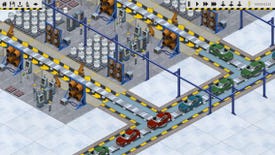Premature Evaluation: Production Line
You can have any genre as long as its Sim
Every week we send Brendan to inspect the factory floor of early access and scribble angry notes about the development carousel. This time, the conveyor belts of Production Line [official site].
Hello, discerning motorist. Set your eyes on the epitome of motorway luxury: the Safe Family Car Xtreme. It is our debut vehicle and comes complete with an engine and wing mirrors. You might think our car company is behind the competition because there is no air conditioning, no cruise control, and no means of listening to music while driving. But don’t worry, we have 16 of our best scientists working round the clock to come up with a CD player right now. There is no reason to be alarmed. No, I mean that literally. The Family Car Xtreme has no car alarm.
Production Line is a car factory sim in which you must arrange bits of an assembly line with as much penny-pinching efficiency as Henry Ford deciding on a budget holiday. You place “slots” (little workstations where the car's innards and outards get added) and then drag conveyor belts through them in the correct order, all heading through quality control and out the door and into an unseen showroom, where your cars will be sold off at the price you set. As you build, your research departments unlock new features – power steering, air bags, automatic windscreen wipers and so on – all of which you have to figure out how to fit in to your half-constructed beltway of robots and engineers. It’s like Big Pharma but with exhaust pipes instead of psychotropic chemicals.
It also takes a few games to get a factory up and running without watching your finances faceplanting into the factory floor. My first factory went bankrupt when I dragged my overhead conveyors (these move components to the workstations as zippily as possible) all over the factory floor like I was playing a very expensive game of Nokia snake. For reasons I suspect are already known to many businessmen, this is not an efficient means of transporting tires from one place to another. My next factory failed when I tried to build a second assembly line that would meet part of the first halfway. A mix-up on my part meant the whole factory ground to a halt and the last of my money vanished like a fart in a hurricane. Even the mid-sized loan I took out wasn’t enough to complete the project.
Much of this early game failure is down to learning the process of being a factory manager, figuring out how all the gamey bits stick together. But some of it is also down to the current lack of any planning tools – a sad omission in a sim that puts so much emphasis on thinking ahead.
I should explain. Let’s say you plant down all the workstations necessary to build the most basic car. The chassis, body, engine, paintwork, accessories, electronics. They all get their own single “slot” where these things are added. You drag a line of conveyor belt between them, then build a quality check and a sales output station at the end. Hooray, cars! But then your research team tells you they’ve made the door locks you’ve asked for, and, later, the electric windows. That’s great, although now you need to fit the door panels individually, rather than as part of one overall body-fitting task. This means you need to delete the “add bodywork” workstation and replace it with several other stations. But look – you haven’t left enough room between this and the other two workstations – the chassis-adder and the engine-adder. You plonker.
Except, you’re only partly to blame. Reworking a line you’ve already made means knowing how much space to leave for future assemblerbits, yes. But the exact dimensions of those upcoming “slots” aren’t visible until you research them. By that time, your factory is already built and functioning. As a result, you’re often left to simply guess how much space the whole chassis-welding process will take up once you’re able to make a single line in all its super-efficient itty-bitty stages. With time you might come to learn the exact space you’ll need to leave between stations (“All right, I need 20 square spaces for the body, 6 for the paint work...”) but that will take more than a few failed games. It’s the type of small yet critical detail I suspect you have to make a pen and paper note about, and then keep in mind at all times. There’s no built-in planner. You can’t even select these research-locked stations and hover a helpful greyed-out version over the factory floor to see how many tiles they will take up. All this means a lot of mistakes (at least, it did for me). Mistakes that I feel I wouldn’t have made if the game just allowed me a little freedom to draw some translucent grey lines or something.
I suspect there’ll be some planning tools added in the future, though, because without them it’s a frustrating opening, deleting the same thing over and over again because you didn’t know to leave an extra space for the hubcaps to get glued on. At the same time, this feels like the whole premise of the game – learning the space needs of each dashboard screw and suspension spring in such minute detail so that the next time you click “new game” will be the time you finally make the perfect car pooper. Many will be happy enough with this trial and error approach. But, for me, it felt like these new player errors are enforced from the moment you draw your first conveyor belt. And often, the only way to correct them is to start anew completely, erasing your whole research tree.
There are ways to combat this. You can use a rudimentary level editor to add a dozen extra zeroes to your total starting cash, for example, and thus never go bankrupt. But this removes any challenge and makes it a waiting game, as you slowly unlock all the puzzle pieces needed to make the production line of your (stress) dreams.
You will also still need to delete and replace much of your old line, sometimes scrapping huge chunks of your previous attempts, plucking things away piece by piece. And although that is basically the whole point of the game, deleting things is currently a pain. You have to do this piecemeal, without the ability to make vast erasing brushstrokes (at least, not one I could find). Deleting the overhead conveyor belts is a particularly fiddly pain. There’s a special deconstruction tool so that you can hold shift and click them away in a fashion that won’t accidentally delete the workstation or belt underneath. But you still have to do this bit-by-bit. I would love a “clear all” button for these conveyors, since their arrangement becomes more and more inefficient and higgledy piggledy as you add more individual bits to the line. A once-in-a-while “deconstruct all overhead lines” button that allows you to re-do everything in a much cleaner sensible way would make the fiddly deletion process far less annoying. But to be fair, better editing tools is another thing that I suspect will eventually come about.
It does get compelling when you finally do get a functional factory going, and there is a sense of satisfaction watching your line pump out luxury cars with panoramic sunroofs and rear-view cameras at a rate of $20,000 per minute. But much of the compulsion to continue is down to the research tree. Other unseen companies will be researching too and every so often a pop-up will warn you that someone has discovered how to install central locking or produce a Sedan with a extra-polished paint job. If three companies all research the same thing, that tech becomes “universal” and it will be expected to appear in your own cars. If you don't have the leather seats everyone else does, people are less likely to buy your rubbish vehicles. This gives the game its impetus and even a certain amount of stressful haste. It’s nothing 20 research offices won’t break (you speed ahead with research with every one of these departments you build) but it does add a sense of keeping up with the competition that becomes the core reason to keep twiddling parts of your assembly line.
The best strategy I found is to make one line do as much as it can possibly squeeze in, then bank all that sweet cash and wait for all the new bits to unlock via your vast research hub. With that money, plus a loan or two, you can build a final immense assembly line, one that manufactures its own components rather than importing them at great expense from other manufacturers. This is the end goal, the final puzzle, and one that I’ve yet to correctly solve.
Once you get to this point, the appeal is clear. It’s for efficiency obsessives – which is exactly what it sets out to be – but it won’t hold much for lovers of more gentle sims. This isn’t about watching your little workers get cross or giggling as teenagers vomit when they step off a rollercoaster. It’s mostly about layout. Putting the right tiles in the right place and operating them at the right speed. I might be at a disadvantage, having not played Factorio or Big Pharma, but it definitely feels like the same sub-genre – a sim for coffee-gulping tweakers and tongue-clicking micro managers.
But even they might find the undercooked editing tools and non-existent planning measures of the current version off-putting, even if the component pieces are all present and correct. In the vanilla (ie. non-cheating) scenarios, fiddling with anything without knowing your exact plan to “space and replace” can be fatal. It’s also annoying to start from scratch so often, since much of the game involves waiting around for everything to become unlocked. There’s also the thematic aspect – Production Line is incredibly dry. Car parts are listed and described with great detail, and there are enough graphs, charts, figures and percentages to make those aforementioned Division of Labour nerds as happy as a running puppy. But there is a lack of character and humour to it which I found a bit lifeless.
Still, it’s clearly for a set of particular folks – squinting and pernickety lip-biters – a group I only halfway fall into. I’m guessing others will find the current faults irritating but forgiveable. But for me, this Sedan still has too many missing parts.
Production Line is on Steam for £11.99/$15.99 or on the developer’s website for the same price. These impressions are based on build 1860303

















